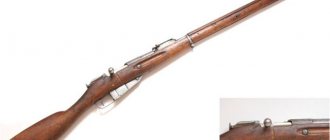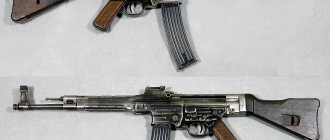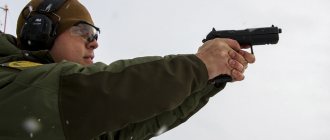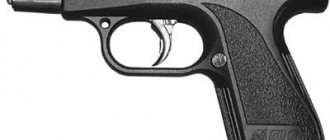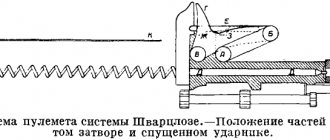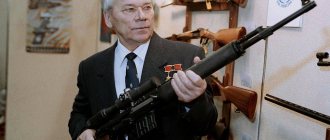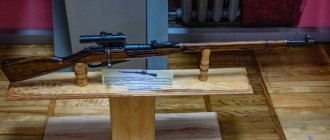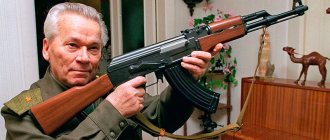Round one: Germans versus Italians
The first stage of the competition began in 1978 and ended in complete failure for all participants.
But the generals, who dreamed of a new pistol, did not calm down. In 1984, the next stage of the “pistol” competition took place. To the surprise of observers, it was not the most famous representative of the great weapons powers who won. It turned out to be the Italian Beretta with its Beretta 92F pistol, which was adopted by the United States as the M9.
Beretta M9
The second, falling short of victory, was the Swiss German from Sig-Sauer - it seems that the SIG Sauer P226 turned out to be too expensive. Although evil tongues said something about a political bribe to Italy for the placement of American missiles at local bases.
But before the American soldiers had time to rejoice at the new cool toy, they discovered that the Italian pistol had, hmm... national flavor.
During the Second World War they joked about Italian tanks that they had six reverse speeds and one forward. The new M9 pistol fired (mostly) forward, but sometimes there was a "mamma mia!" - and then pieces of the pistol flew into the shooter’s face.
Representatives of Beretta called “on the carpet” to the question: “Why did the production samples suddenly begin to fall apart, although everything was fine during testing?” they wringed their hands picturesquely and muttered something in Italian about a difficult childhood and the simplification of technology in mass production. The generals turned out to be ungrateful spectators, so they suspended the contract with the company.
Beretta 92FS
The Italians urgently manufactured a modification of the Beretta 92FS and installed a special part that prevents the bolt from flying into the shooter's face in case of destruction. But changes were made only to pistols for the US Army. For everyone else, Beretta calmly sold the old model - which, in particular, caused the French police to get burned.
Paradox
The American arms industry is going through hard times.
The former monsters - the largest arms corporations - are barely surviving in the civilian market, and there is simply no money for programs to create army weapons capable of competing with European models. Attempts to ban the import of foreign weapons into the United States lead to nothing: they introduced an embargo on the import of Chinese rifles, banned Russian ones - nimble Italians, Germans, Czechs, Turks entered the market... Colt's Manufacturing Company went bankrupt back in the early 90s, the company Remington Arms also filed for bankruptcy in February of this year. It’s a paradoxical situation: the richest country in the world with the strongest army is not able to develop weapons for itself.
Round two: pistols versus money
In the 21st century, the American army began to follow fashion more closely than in the 20th. And although a measly thirty years had passed since the previous competition, the generals again wanted a new pistol.
By this time, the market for service pistols in the West was divided into two parts: “Glock” and “all sorts of riffraff.” However, the contract from the American military looked so good that even Glock put a non-automatic safety on the proposed model. Having stepped on the throat of the song that has been sung for many years, that on Glocks this detail is completely useless.
Taking into account the established reputation of the Glock as both a service and army pistol, the result of the competition seemed predictable. But the Americans surprised everyone.
SIG-Sauer P320 (photo: Source)
The SIG Sauer P320 was declared the winner - it was he who was entrusted with the honor of becoming the M17 Modular Handgun System. SIG met the formal requirements of the competition so much that some employees of the news agency “One Grandma Said” began to argue that all the requirements were written in advance for a specific sample.
In fact, the deciding factor was the price. SIG offered its pistol kit for $100 million cheaper than Glock wanted.
The Austrians were so surprised by the results of the competition that they were not too lazy to protest them. The protest was rejected, although by this time there was not very good news about the pistol that served as the basis for the M17.
American advanced small arms program NGSW: finale or fiasco
The armed forces of the leading countries of the world are maximally saturated with high-tech equipment - satellites, airplanes and helicopters, ships and submarines, tanks and artillery.
It would seem that with so many high-tech combat vehicles, the role of small arms should be small?
However, in reality this is not at all the case - until now, in wars and military conflicts, small arms ensure the defeat of about 30-70% of enemy soldiers from the total number of killed and wounded - this issue was previously discussed in the article Combat suit. Statistics of wounds, bullets and fragments.
Gunshot wound statistics
Thus, the importance of small arms in the armed forces is difficult to overestimate.
At the same time, revolutions in small arms have not occurred for a very long time; perhaps we can say that the development of small arms stopped somewhere in the 50s and 60s of the 20th century, when the Kalashnikov assault rifle with an intermediate cartridge of 7.62x39 mm and a rifle appeared M-16 chambered for a low-impulse intermediate cartridge of 5.56x45 mm caliber.
Since then, all programs for the creation of small arms and promising ammunition for them have ended in nothing.
The evolution of small arms largely stopped in the middle of the 20th century
It is characteristic that, based on statistical data, small arms are the best in terms of the “cost/effectiveness” criterion compared to any other types of weapons, in terms of the cost of defeating enemy soldiers.
This issue was discussed in the article The Economics of War. How much does the machine cost? The same article examined American programs of the previous century to create promising small arms.
Similar programs of the USSR were discussed in the article Evolution of the assault rifle in the USSR and Russia in the context of the American NGSW program.
In the 21st century, the United States made another attempt to create a promising new generation squad small arms (Next Generation Squad Weapon or NGSW), which includes the NGSW-R rifle (Next Generation Squad Weapon Rifle), designed to replace the M-4 rifle, and the NGSW machine gun -AR (Next Generation Squad Weapon Automatic Rifle), designed to replace the M249 machine gun.
The winner of the NGSW program must be determined in the period from August to October 2022, accordingly, the time has come to sum up the interim results, especially since they can already be predicted with a fairly high probability.
Initially, quite a lot of companies participated in the NGSW program, including: VK Integrated Systems, Bachstein Consulting, MARS Inc., Cobalt Kinetics, AAI Corporation Textron Systems, General Dynamics-OTS Inc., Sig Sauer Inc., FN America LLC, PCP Tactical LLC .
After the preliminary selection, only three companies (groups of companies) remained - Textron Systems, Sig Sauer and LoneStar Future Weapons/True Velocity (General Dynamics/Beretta).
Textron Systems
The Textron Systems weapon can be called the most innovative of all the presented samples, primarily because of the telescopic cartridges with a plastic sleeve used in it.
The advantage of this cartridge is that it weighs approximately 35% less than an equivalent cartridge with a conventional brass case. Another advantage is the lower thermal conductivity of the plastic sleeve, which ensures less heating of the chamber.
The specificity of cylindrical telescopic ammunition allows small arms manufacturers to experiment and consider new weapon layouts that are difficult or even impossible to implement with conventional cartridges of a traditional layout.
Rifle, machine gun and telescopic cartridge of 6.8 mm caliber, developed by Textron Systems as part of the NGSW program. Image textronsystems.com
Presentation by Textron Systems
However, despite its innovativeness, one might even say revolutionary nature, and perhaps because of this, Textron Systems’ weapons dropped out of the NGSW program.
LoneStar Weapons/True Velocity
An equally innovative model of small arms being developed as part of the NGSW program is the rifle/machine gun from LoneStar Future Weapons.
It also uses polymer cased cartridges made by True Velocity, but not telescopic, but in the classic format.
Small arms and cartridges developed under the NGSW program by a group of companies: LoneStar Future Weapons, True Velocity, General Dynamics, Beretta. Image from beretta.com
Presentation by LoneStar Future Weapons
The advantages of LoneStar Future Weapons include compactness provided by the bullpup layout, lightweight cartridges, whose weight, according to the manufacturer, is 30-40% less than cartridges of a similar format made of brass, less heating of the chamber due to the use composite sleeves and a recoil reduction system using recoil of the barrel and receiver.
Nevertheless, specialized publications often voice the opinion that the LoneStar Future Weapons small arms developed as part of the NGSW program are doomed to failure.
First of all, the fact is that the bullpup layout is often perceived negatively in the context of its use for machine guns/assault rifles. Comments on the recently published article Automatic rifles: bullpup versus normal layout only confirm this opinion. This arrangement is also not popular in the US military.
Another potentially significant drawback is the inability to use belt-fed in the light machine gun variant, at least there is no information about this weapon being belt-fed.
The use of high-capacity magazines does not compensate for this - they are by default less reliable, and their use in a bullpup configuration is not very convenient, and without a high-capacity magazine - what kind of machine gun is this with a magazine for 20 rounds?
The ejection of cartridges in front of the shooter’s face does not add any advantages to this weapon - in modern bullpup weapons, the ejection of cartridges is carried out downward or forward.
If for left-handed/right-handed people the weapon can be reconfigured to eject cartridges to the right/left, then what should be done with the powder gases ejected under the shooter’s nose?
Sig Sauer
Sig Sauer is clearly on the rise - it recently won a tender for a new military pistol for the US Army.
The Sig Sauer MCX Spear small arms, developed as part of the NGSW program, are perhaps the most conservative of all the presented samples.
It is manufactured according to the normal layout scheme, the 277 SIG FURY cartridge is all metal, albeit with a hybrid case that includes a stainless steel base and the rest is made of brass.
There is no information about any measures to actively reduce recoil, which is quite natural, given that the design of the MCX Spear weapon is developed on the basis of the already produced SIG MCX modular platform, where there are no such frills.
Small arms and ammunition developed by Sig Sauer as part of the NGSW program. Image by sigsauer.com
Presentation by Sig Sauer
By the way, business is business - the MCX-SPEAR rifle with an SLX silencer chambered for 277 SIG FURY is already available for purchase in a civilian version (not in Russia, due to sanctions) at a price of $7,999.00.
Please note that the 277 SIG FURY cartridge of 6.8x51 mm caliber is made in the dimensions of the .308 Win or 7.62x51 mm cartridge, an old unified NATO cartridge created before the advent of the 5.56x45 mm cartridge, which is still widely used in countries NATO is also popular in the civilian segment.
In the MCX Spear and MCX Raptor family rifles, in about 5 minutes you can change the caliber from 277 SIG FURY to 7.62x51 mm or 6.5 Creedmoor - an increasingly popular hunting cartridge, also created in the dimensions of the 7.62x51 mm cartridge.
Sig Sauer has also developed a version of the MCX Raptor with a barrel length of 8 inches or 200 mm, which is much shorter than even the version of the civilian Saiga 308 carbine. 46 with its barrel length of 350 mm.
Most likely, the MCX Raptor realizes its capabilities only when using cartridges with fast-burning powder, since the Saiga-308 with a short barrel has a sound and flash of a shot reminiscent of a shot from a howitzer, and without a good muzzle brake compensator (DTK), shooting from it is very uncomfortable ( Without headphones, you can damage your hearing).
Finale or fiasco?
What will be the outcome of the NGSW program?
The sensations are twofold.
On the one hand, we can say that with a high probability the winner has been determined - this is the Sig Sauer company with the MCX Spear rifle and the 277 SIG FURY cartridge.
This weapon will most likely be quite good, at least the author would definitely not refuse the civilian version of the MCX Raptor.
On the other hand, it is hardly possible to call this weapon revolutionary.
Yes, the range and accuracy of shooting at long distances will increase, and the likelihood of penetrating personal armor protection (PIB) will increase. Polymer cartridges were abandoned - it would not be possible to significantly reduce the weight of the ammunition. There will also be no telescopic cartridges - no new layout schemes or technical solutions.
To what extent are the new weapons developed under the NGSW program superior in performance to the small arms that were created 70 years ago chambered for 7.62x51 mm?
The 277 SIG FURY cartridge in 6.8x51 mm caliber is an evolutionary development of the .308 Win or 7.62x51 mm NATO cartridge. Without recoil reduction systems, it was impossible to fire bursts normally from it before, and it will be impossible now.
If you take a 7.62x51mm cartridge with a fast burning powder, optimized ballistics bullet, how much will it lag behind the 277 SIG FURY cartridge?
The latter will have a slightly flatter trajectory, slightly higher bullet speed at long range, and slightly less wind drift...
The FN SCAR-H and Heckler & Koch HK-417 Marksman rifles can be chambered for the 277 SIG FURY cartridge or its equivalent through a simple upgrade. Image from wikipedia.org
The question is that shooting at a range of about 1,000 meters, where the 277 SIG FURY cartridge shows its advantages over the 7.62x51 mm cartridge, requires special skills from shooters - will the average soldier be able to realize the potential of this weapon when shooting at such a range?
And at 1000 meters it’s better to shoot with a cartridge like .338 Lapua Magnum.
Shooting at 600 meters with the 277 SIG FURY cartridge may be easier than with existing 7.62x51mm cartridges - that is, unless a similar high-pressure cartridge with fast-burning powder and a ballistics-optimized bullet is created in 7 gauge, 62x51 mm.
With a range of about 300 meters or less, everything is even more difficult: effective burst shooting from the Sig Sauer MCX Spear is a big question, compared to the same M-4 rifle or a Kalashnikov assault rifle of 5.45x39 mm caliber.
The conclusion is that the Sig Sauer MCX Spear is a typical Marksman rifle. It can be used by professionals who consciously make such a choice, but it is of little use for arming mass armies. It is doubtful that it will replace the M-4 carbine in the US military.
On the other hand, there is a possibility that the United States wants to fundamentally change the shooting training of fighters with a move away from burst shooting and a transition to the predominant use of rifles in semi-automatic mode with the use of advanced sighting devices, also being developed as part of the NGSW program, which we will talk about in another material .
But even in this case, there is a possibility that the United States should “cut the sturgeon” - the power of its cartridges, developed under the NGSW program, may be excessive for the average fighter.
Do the Russian Armed Forces need to take any action to counter possible threats from the American NGSW program?
First of all, it is necessary to improve the manufacturing quality of domestic cartridges in existing calibers. Until now, Russian cartridges are significantly inferior in manufacturing quality to Western ones, and this affects, first of all, the accuracy and accuracy of fire. What kind of future is there...
Secondly, it is necessary to immediately begin the development and introduction into troops of tactical suppressors designed for use with supersonic cartridges. Such mufflers, in comparison with standard DTKs, provide a significant reduction in the sound of a shot and almost completely eliminate the muzzle flame.
This allows for less unmasking of the shooter’s position, improved control in combat due to better recognition of commands and situational awareness of fighters whose hearing is not damaged by excess sound waves.
The use of tactical silencers is especially important when working in buildings - it is difficult to imagine how our soldiers fought in Chechnya when clearing premises without silencers or active headphones, and there is no doubt that they received significant hearing damage and concussion.
Thirdly, developments that were carried out back in the USSR can be revived.
One of these developments is discussed in the article Forgotten Soviet 6x49 mm cartridge versus 6.8 mm NGSW cartridge.
The 6x49 mm cartridge has less energy compared to the American promising 277 SIG FURY cartridge, but more energy than can be obtained in calibers 5.45x39 or 7.62x39 mm. The 6x49mm cartridge has a flat bullet trajectory, and the lower recoil it creates compared to the 277 SIG FURY cartridge will allow it to be used effectively at close range when firing in bursts, especially when using recoil compensation circuits and tactical suppressors.
Concepts of an assault rifle and a Marksman rifle chambered for 6x49 mm based on the AN-94 assault rifle, made by guns.ru forum member NEZNAIKO
To summarize, it seems that every time, within the framework of the next program of promising small arms (whether it is carried out: in the USA, in Germany
(remember the H&K G11)
or in the USSR), samples are created that make it possible, if not to make a revolution, then to bring small arms to a qualitatively new level, something is preventing us from bringing the work to a victorious conclusion.
Maybe the relevant technologies have not yet “ripened”, or perhaps the armed forces are simply too conservative and filter out the most revolutionary solutions?
In the case of the same American NGSW program, the potential winner (with a high probability) is the Sig Sauer MCX Spear rifle, which is essentially just a slight modernization of a previously developed weapon, like the 277 SIG FURY cartridge, which can be considered the ideological heir to the 6 hunting cartridge, 5 mm Creedmoor, which, in turn, is often considered as the successor to the 7.62x51 mm combat and hunting cartridge.
It is characteristic that the appearance of the 6.5 mm Creedmoor cartridge did not require any rearmament programs - just market requests, and to use it it is enough to replace the barrel on the weapon that has this capability.
6.5mm Creedmoor cartridges (left and center) next to 7.62x51mm cartridge (right). Image from wikipedia.org
It can hardly be said that the NGSW program definitely ended (will end) in a fiasco, but one cannot expect any outstanding achievements from it.
Nevertheless, this is not a reason to rest on our laurels, because one way or another, the concept of mass small arms for mass armies will meet modern requirements less and less. The armed forces of the near future will require new, more effective rifle-cartridge systems, equipped with modern sighting devices and other auxiliary modules/systems.
Why are guns so important to America?
“The Man with the Gun” is the arbiter of American history, its main tradition, the iconic figure of its righteous and villains, the fiend of evil and the warrior of good. The US Supreme Court writes this about the right to own guns:
“The possession of weapons is sacred, and woe to those who encroach on them: in the face of this inviolable right, even federalism retreats, the legislative power of individual states does not act.”
Even more interesting are quotes from Professor John Lott, “More Guns, Less Crime: Towards Understanding Crime and Gun Control Legislation.” The author confirms that owning and carrying weapons by law-abiding citizens reduces the number of violent crimes:
- criminals fear armed resistance,
- an armed victim of criminal attacks has a better chance of defending himself.
J. Lott, analyzing national statistics, discovered that:
The more the population gains the right to bear arms, the more violent crime decreases. “Every year the law on concealed carrying of pistols and revolvers is in effect, the murder rate decreases by 3%, rape by 2%, and robbery by more than 2%.” At the same time, neither the level of accidental deaths from careless handling of weapons nor the number of suicides with their help increases.
NRA
statistics, no more than 7% of armed criminals acquired weapons legally, while others use smuggling and other illegal supplies.
The NRA confirms the effectiveness of self-defense with even more clear figures. Thus, in Washington, the ban on carrying concealed weapons from 1976 to 1991 acted as a catalyst: the murder rate tripled, although during the same period throughout the country it increased only by 12%.
California's murder and violent crime rates are 28% and 32% higher, respectively, than the nation as a whole. And in Virginia, where a permit is obtained directly from the store without a “probation period,” there are 34.6% fewer violent crimes, 3.7% fewer murders, and 76.9% fewer robberies.
Surprisingly, freely carrying weapons even reduces the number of mass shootings like what happened in Los Angeles. Since the passage of concealed-carry laws, the number of victims of mass murderers has dropped sharply. Between 1977 and 1995, this figure fell by 91% .
What do you think about freely carrying weapons?
( 12 votes, overall rating: 4.67 out of 5)
